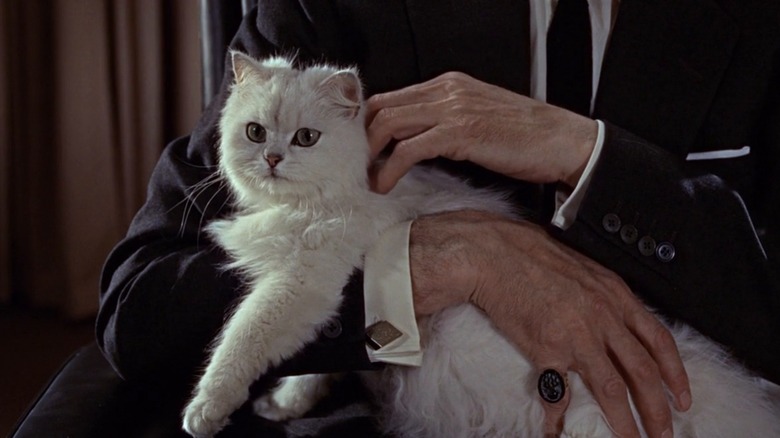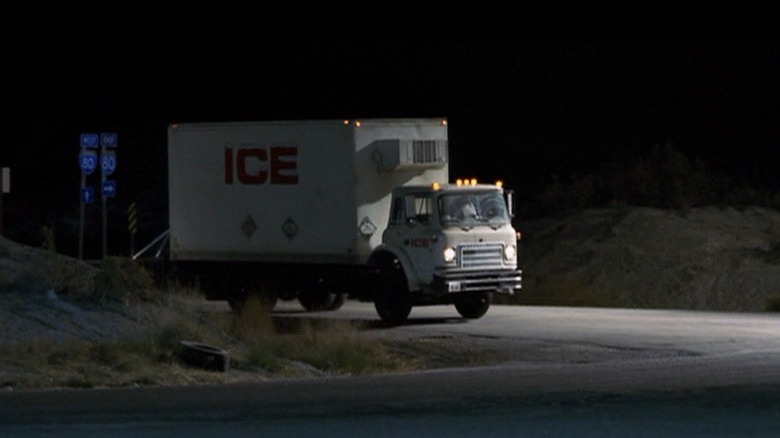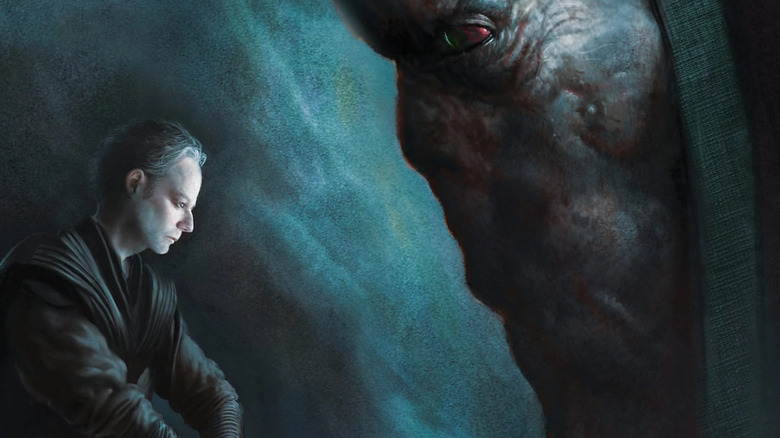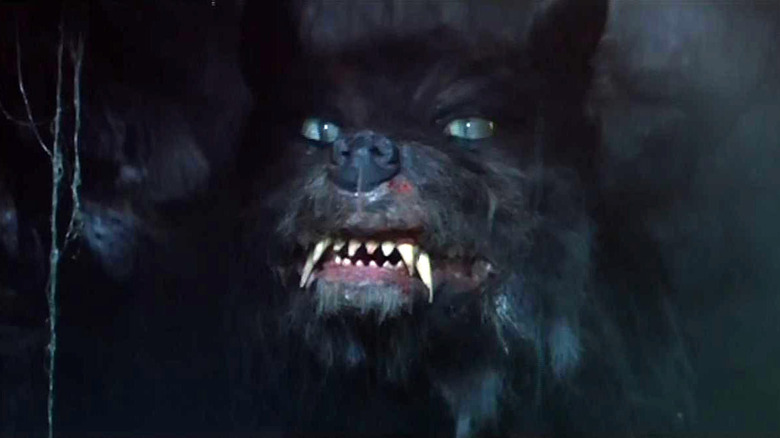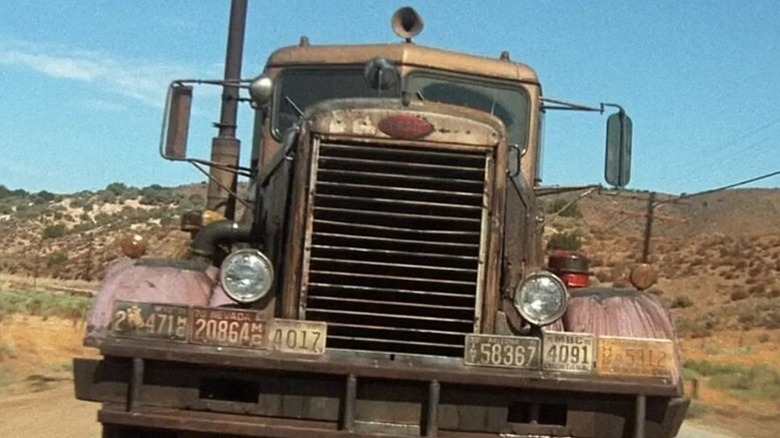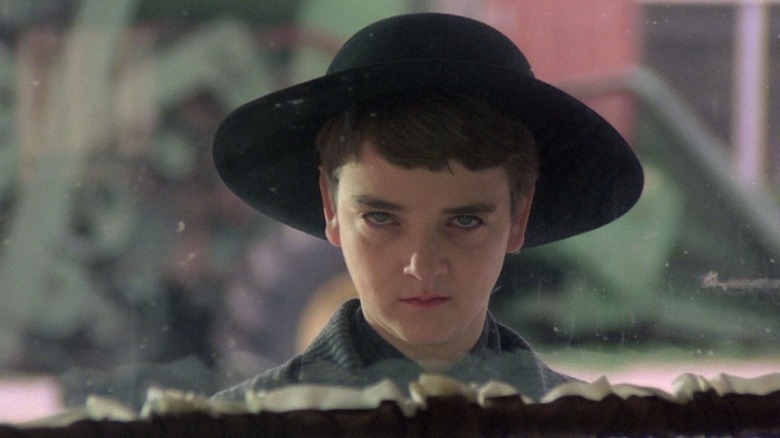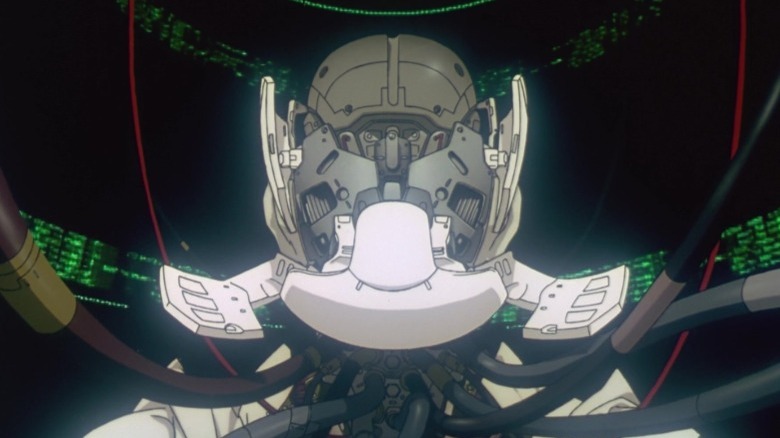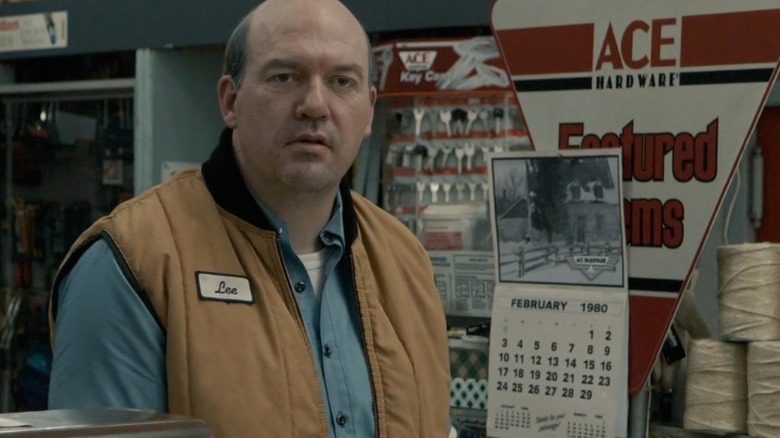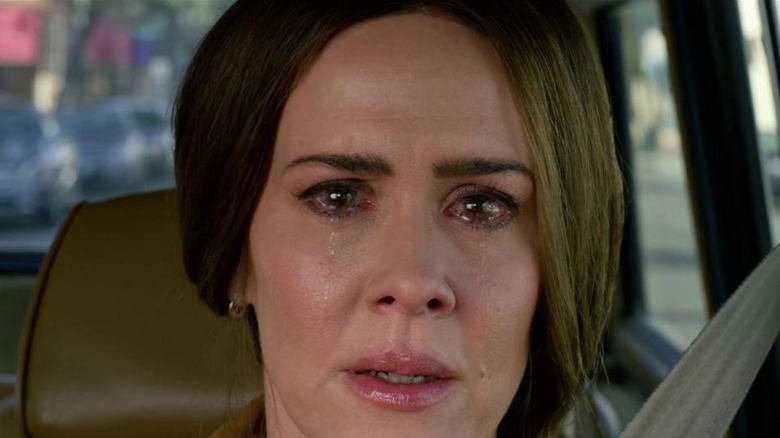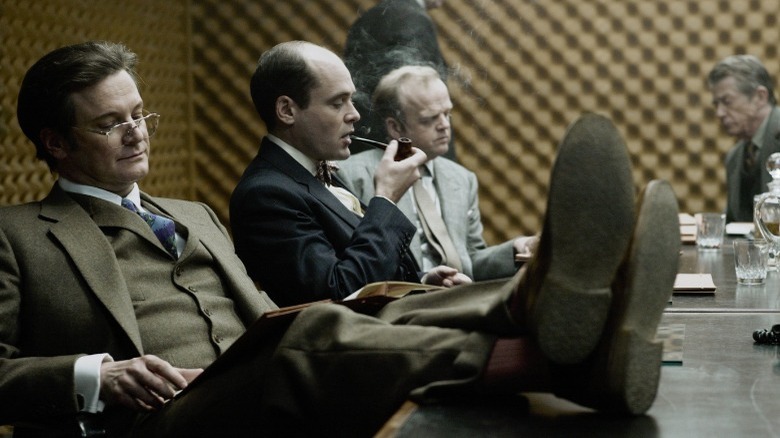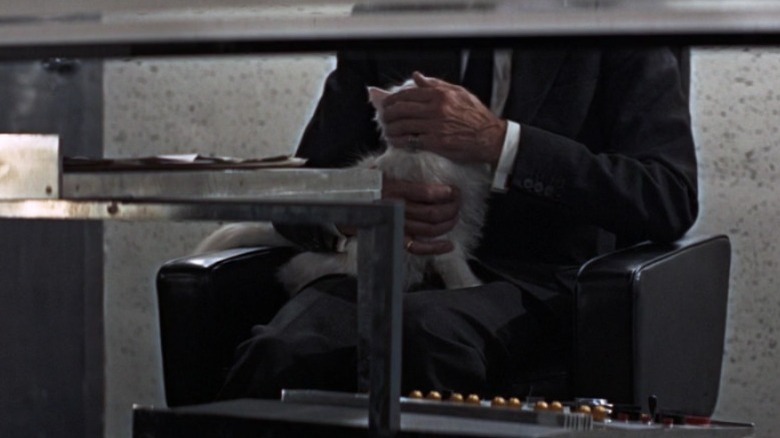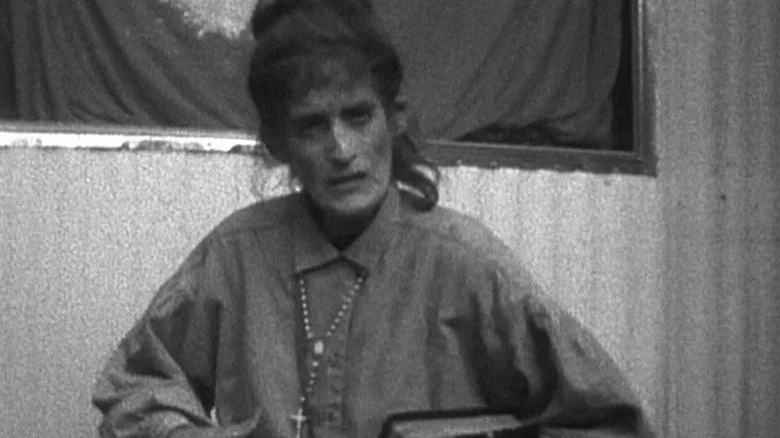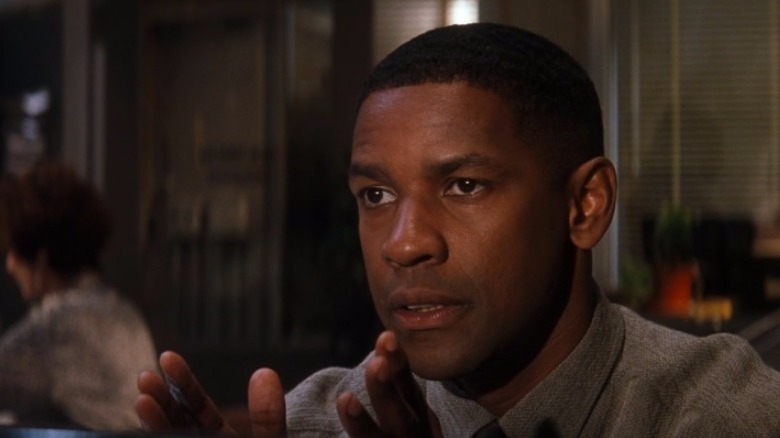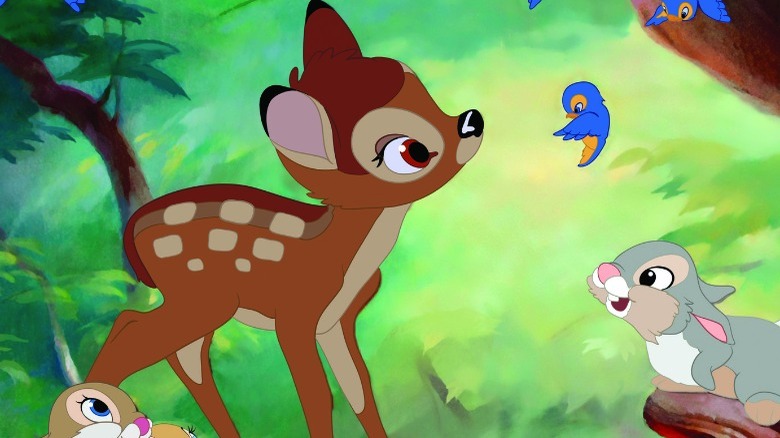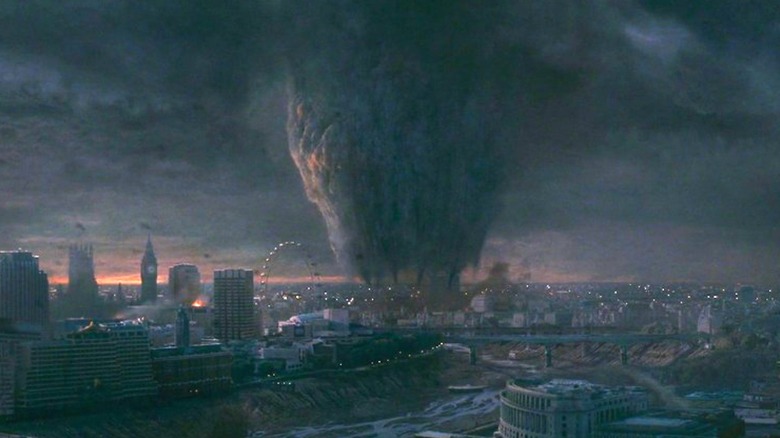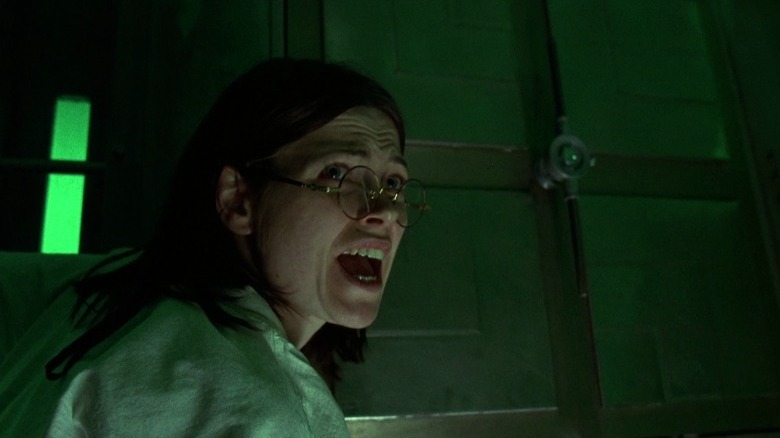15 Movie Villains That Are Never Shown On Screen
The villain is just as important in any good story as the hero. That holds true regardless of the medium, so movies also require impressive antagonists to captivate audiences. Just think of what films like "Star Wars" and "The Dark Knight" would be without the likes of Darth Vader and the Joker. What makes these villains so great is that they have their own motivations and backstories rather than just trying to stop the hero for no good reason.
While big bad guy movie reveals can be a dramatic and surprising way to introduce a villain, some films go in the complete opposite direction. In these types of movies, the villain never actually appears on screen, leaving it up to the audience to imagine what they might look like. This can be an excellent tactic to help make scary figures even more terrifying or to add an extra layer of suspense to the story. Whatever the case, these villains remain unseen, lurking in the shadows as they go about their evil schemes.
Rusty Nail - Joy Ride
In the same year that Paul Walker starred in "The Fast and the Furious," the actor also had a role in the road thriller "Joy Ride." Co-produced and co-written by J. J. Abrams, the film stars Walker and Steve Zahn as two brothers on a long road trip to visit their old friend Venna (Leelee Sobieski). After playing a prank on a trucker called Rusty Nail through a CB radio, the two end up being pursued by the vindictive villain. Throughout the 2001 film, Rusty Nail continuously threatens them and eventually kidnaps Venna and her friend Charlotte (Jessica Bowman).
Despite being the primary antagonist in "Joy Ride" and having constant radio communications with the Thomas brothers, Rusty Nail's face is never actually shown. Instead, his disembodied voice, portrayed by Ted Levine, provides a menacing presence that works well precisely because viewers don't know who it belongs to. Glimpses of his body are briefly seen, but these moments give no idea of who Rusty Nail really is. Unfortunately, subsequent entries in the franchise provide more information about the terrifying character and even show his full appearance.
Darth Plagueis - Star Wars
Darth Plagueis may not be a name that casual fans of "Star Wars" are familiar with. After all, he's only briefly mentioned in the prequel trilogy and doesn't make any physical appearances. Yet, none of that diminishes his significance to the events that happen, especially in the build-up to "Star Wars: Episode I -– The Phantom Menace." Of course, Plagueis isn't even named before "Star Wars: Episode III -– Revenge of the Sith."
A detailed history of Darth Plagueis is only available in various Expanded Universe storylines that are no longer canon. Sheev Palpatine (Ian McDiarmid) talks about the Sith Lord when trying to seduce Anakin Skywalker (Hayden Christensen) to the dark side of the Force, revealing he was a powerful Sith who discovered the secret to immortality. It later becomes clear that Palpatine was his apprentice, eventually murdering his mentor to assume the title of master.
Fans have long speculated that Darth Plagueis, through his efforts to create life with midi-chlorians, may have been responsible for Anakin Skywalker's fatherless birth. George Lucas even acknowledged these theories in an interview with Rolling Stone, saying, "Is Anakin a product of a super-Sith who influenced the midi-chlorians to create him, or is he simply created by the midi-chlorians to bring forth a prophecy, or was he created by the Force through the midi-chlorians? It's left up to the audience to decide."
The Nothing - The NeverEnding Story
Even though "The NeverEnding Story" is essentially a children's film, it's a rather dark and bleak tale. Based on Michael Ende's novel of the same name, the 1984 movie follows 10-year-old Bastian (Barret Oliver) as he discovers a magical book that tells the story of a fictional land called Fantasia. In this strange world, an evil force known as the Nothing threatens to consume all, prompting the Childlike Empress (Tami Stronach) to send Atreyu (Noah Hathaway) to try and stop the destruction.
Represented by a devastating, swirling storm, the Nothing is a shapeless threat that seemingly has no motivations or desires. Yet, it is clearly intelligent, as it sends out the wolf monster Gmork (Alan Oppenheimer) to hunt down Atreyu so that its own mission can be completed. The Nothing ultimately manifests humanity's dwindling imagination and lack of belief, leaving a vast emptiness behind where there were once rich make-believe worlds.
The Truck Driver - Duel
Steven Spielberg established himself as a Hollywood star in 1975 when he directed "Jaws." That film features a malevolent shark that's rarely seen on screen, with the director taking inspiration from Alfred Hitchcock's horrors to understand that what you can't see is often scarier than what you can. The legendary director may also have borrowed the idea from one of his earlier films, where the villain is hidden and remains a mystery to the audience.
"Duel," which was released on ABC in 1971 and is one of Spielberg's earliest projects, follows David Mann (Dennis Weaver) as he travels across the country on a business trip. Along the way, he encounters a sinister truck driver who goes out of his way to taunt Mann and later attempts to kill him by ramming him off the road. Viewers only get glimpses of this figure, with momentary shots showing his arms or legs. This helps make the villain even more menacing, as his pursuit of Mann and his motives are completely unknown for the entire movie.
He Who Walks Behind the Rows - Children of the Corn
The horror genre would be a very different place without Stephen King. While the author's many movie and TV adaptations have had mixed success, there's little denying King's immense influence. "Children of the Corn" is one of the better-received releases based on King's work, hitting cinema screens in 1984 and telling the story of a group of murderous children. Burt Stanton (Peter Horton) and Vicky Baxter (Linda Hamilton) encounter the young members of this strange cult, who have murdered all of their town's adults, and try to escape before the youngsters sacrifice them.
Led by Isaac (John Franklin), the children worship a demonic entity known only as "He Who Walks Behind the Rows." This false god resides in the cornfields surrounding the town, manipulating the children of Gatlin, Nebraska into carrying out its wishes. Only the children themselves are shown, with He Who Walks Behind the Rows remaining in the background as a sinister being. Of course, this gives audiences the opportunity to interpret the villain in different ways and perhaps even come to the conclusion that the demon doesn't actually exist.
The Puppet Master - Ghost in the Shell
Based on the Japanese manga of the same name, the 1995 anime film "Ghost in the Shell" follows cyborg Mj. Motoko Kusanagi as she pursues a rogue artificial intelligence known as the Puppet Master in a near-future version of Japan. This hacker can take control of a cyborg's body — referred to as a shell — without the person's consciousness realizing what is happening. It's seen inhabiting the shells of various individuals, but as an AI, it has no face or body of its own.
Not only does this add a sense of foreboding to the apparent villain, as he could essentially be anyone, but it also feeds into the film's philosophical themes dealing with self-identity and what it means to be human. In the end, it's revealed that the Puppet Master wants little more than to be recognized as a sentient being with all the rights and protections that come with that.
The Zodiac Killer - Zodiac
"Zodiac" is a 2007 thriller inspired by the real-life story of the Zodiac Killer and largely based on books by Robert Graysmith dealing with the serial murderer. It stars Mark Ruffalo and Anthony Edwards as two law enforcement investigators alongside Jake Gyllenhaal and Robert Downey Jr. as reporters hunting down the Zodiac Killer. Set in San Francisco during the 1960s and 1970s, the film shows how the city became gripped with fear as the mysterious killer continued to murder victims, all while taunting his pursuers with cryptic messages and ciphers.
Just as in real life, the identity of the Zodiac Killer is not revealed in the film. Several suspects are touted as likely candidates — including Arthur Leigh Allen (John Carroll Lynch) — yet none of them are confirmed to be the monster. The film clearly implies Allen is probably the killer and even ends with a message saying he died before police could question him, but "Zodiac" ultimately doesn't identify the Zodiac Killer, meaning he may well not appear at all throughout the story.
The Entities - Bird Box
Netflix released the post-apocalyptic horror movie "Bird Box" in 2018, prompting a wave of memes as people attempted to do everyday tasks while blindfolded. Set in a world where the human population has almost been wiped out, the film charts Malorie Hayes' (Sandra Bullock) attempts to keep herself and her children alive. To do so, they must keep their eyes covered to ensure they don't look at the Entities, an evil force that compels anyone who sees them to end their lives in horrific and painful ways.
The entire concept of "Bird Box" is that the monstrous enemy cannot be seen without dying. It makes sense, then, that the Entities are never actually depicted on screen, as this adds to the mystery and leaves it up to the viewer to decide what they could be. The unknown remains far scarier than any monster design could have been.
Karla - Tinker Tailor Soldier Spy
"Tinker Tailor Soldier Spy" is a thriller that focuses on MI6's hunt for a mole providing information to the Soviet Union during the Cold War. With vital intelligence data making its way to Karla, a secretive Soviet intelligence officer, a collection of British spies try to discover the double agent and uncover webs of conspiracy that go to the very highest levels of the agency and the U.K. government.
It would have been surprising if "Tinker Tailor Soldier Spy" showed Karla, with the Soviet spy remaining something of a mystery throughout John le Carré's novels. In fact, his identity is part of his appeal in the books, with the character operating through underlings and only known through his codename. The closest viewers come to seeing him is a brief moment when the figure is seen in a café holding Smiley's lighter, although he can also be heard at various points with the voice of actor Michael Sarne.
Ernst Stavro Blofeld - From Russia With Love
Within the "James Bond" novels and films, Ernst Stavro Blofeld could reasonably be said to be the overarching villain. He's the secretive head of SPECTRE, leading the criminal organization across the entire planet. Using seemingly unlimited resources and a group of other criminal masterminds, Blofeld aspires to take over the world. His first mention comes in "From Russia With Love," and he later appears or is referenced in several other films.
A trademark of his early appearances, including both "From Russia With Love" and "Thunderball," is that the character isn't fully shown. The enigmatic villain is only referred to as Number 1 — hinting at his high status within SPECTRE — and seen in part, usually with a shot showing his hands stroking a white Persian cat. The antagonist also has some speaking lines in these early films, but he remained unseen until finally meeting Bond and being revealed in "You Only Live Twice."
The Blair Witch - The Blair Witch Project
"The Blair Witch Project" helped revitalize the horror genre when it was released in 1999. Through fictional "lost footage," the movie tells the story of three students who travel to a town in Maryland in the hopes of filming a documentary about a mythical murderer known as the Blair Witch. The footage depicts the students interviewing local residents and discovering a rich history in the area of people going missing, as well as several possible suspects for the Blair Witch herself.
As the film enters into its second half, supernatural events begin to happen, and the students appear to be pursued and tormented by an unseen force. Now lost in the woods, the three lose hope and are finally assaulted by an entity that terrifies them. "The Blair Witch Project" is one of the scariest horror films of its time, and this is helped by the fact that the titular witch is never shown. Hints are given as to who she may be, but nothing is confirmed. The audience only gets creepy stick figures made from branches, blood-soaked rags, and unidentifiable sounds to work with.
Azazel - Fallen
"Fallen" is a 1998 supernatural thriller that stars Denzel Washington as Philadelphia police detective John Hobbes. Having spent years chasing down serial killer Edgar Reese (Elias Koteas), Hobbes visits the killer one last time in prison before he is executed. However, soon after Reese's death, similar murders occur across the city with the same occult methods. Along with his partner, Detective Jones (John Goodman), Hobbes learns that an evil spirit known as Azazel may be responsible for the killings.
As a demonic entity, Azazel's true form is unclear. The evil spirit possesses numerous people throughout "Fallen," including Reese, Hobbes, and Jones, using their bodies as hosts to carry out his deadly plans. He simply has to touch a victim to assume their form and even manages to possess a cat at the end of the movie to survive Hobbes' attempt to kill him once and for all.
Man - Bambi
One of the earliest Disney films, "Bambi" tells the story of a young deer who befriends a rabbit named Thumper and a skunk called Flower. As he slowly matures, Bambi witnesses many horrors caused by a force referred to only as Man, including the traumatic death of his own mother who is shot by a hunter. Learning that he is the son of the Great Prince of the Forest and will eventually assume that role himself, Bambi is forced to protect those around him and help ward off the evil that threatens their home.
The fact that the enemy is known simply as Man and never actually shown could well be because the villain is meant to act as a metaphor for humanity as a whole. It's the kind of villain that's rare in Disney movies, which are often filled with over-the-top witches and monsters rather than realistic antagonists. This makes "Bambi" all the more terrifying, with "Man" representing an unseen horror that's feared by all animal-kind and cannot be defeated.
Galactus - Fantastic Four: Rise of the Silver Surfer
Long before the MCU made Marvel properties into billion-dollar blockbusters, Fox found some success with its "X-Men" and "Fantastic Four" series. 2007's "Fantastic Four: Rise of the Silver Surfer" sees the Silver Surfer (Doug Jones) arrive on Earth to prepare the planet for destruction at the hands of Galactus. As the Silver Surfer launches attacks, the Fantastic Four ally with their long-time nemesis, Doctor Doom (Julian McMahon), to save Earth. After discovering that the Silver Surfer has been forced into serving Galactus, the Fantastic Four work with him to stop the alien villain.
Although the Silver Surfer is the primary antagonist, Galactus is the ultimate villain and the person controlling the events. Yet, the titanic supervillain only appears as an ominous cloud of smoke slowly bearing over the planet. This may be a nod to his comic book portrayal, where the cosmic nature of Galactus means almost no one can comprehend his true form, leading to different species perceiving him in unique ways.
The trap's creators - Cube
The concept of "Cube" will be familiar to anyone who's seen any entries in the "Saw" franchise. This 1997 release essentially started the trapped room genre and launched its own series of films. The story follows a group of strangers who wake up in prison cells without recollecting how they got there. Facing a series of deadly booby traps, the group has to work together to try to escape. Amid rising tensions, former police officer Quentin McNeil (Maurice Dean Wint) becomes the main antagonist as he violently lashes out at his fellow inmates. But he is not responsible for constructing the mysterious building or trapping those who are imprisoned inside.
Unlike "Saw," this horror flick doesn't have a central villain like Jigsaw driving events forward –- at least, not one that's visible. Exactly who is ultimately behind the events in "Cube" remains a mystery. Subsequent sequels suggest that this entity is a corporation known as IZON. Among the many philosophical discussions that take place in the first film, the characters discuss the true purpose of the cube, and no one can come up with a good answer that makes sense.
